#National Parks 🏞️
Explore tagged Tumblr posts
Text
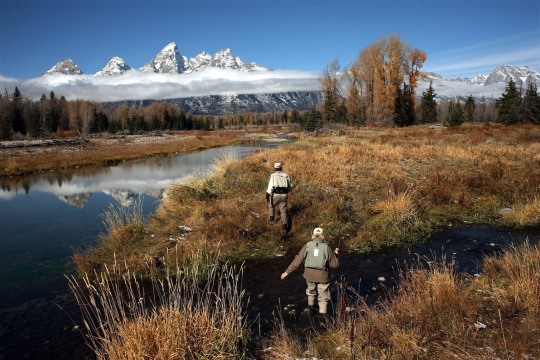
Fly fishers walk toward a stream in Grand Teton National Park, Wyoming, as the jagged mountains for which the park is named rise in the distance. Grand Teton draws both adventurers, for activities like mountain climbing and backcountry skiing, and leisure travelers, for boating, hiking, and fishing. Photograph By Aaron Huey, National Geographic Image Collection
How to visit Grand Teton National Park!
With Soaring Mountains and Braided Rivers, this Wyoming Park Epitomizes the American West. Here’s What You Need to Plan the Ultimate Trip.
— May 09, 2023
Fast Facts:
Location: Wyoming
Established: February 26, 1929
Size: 310,000 acres
Annual Visitors: About 2.8 million in 2022
Visitor Centers: All four are open from spring to fall; check the website for specific dates. Every center except the Laurance S. Rockefeller Preserve Center issues backcountry and boat permits. Flagg Ranch Information Station is a helpful trip planning stop, when entering from the south end of Yellowstone National Park.
Entrance Fee: Per vehicle and individual; annual passes available
Sharpened by glaciers, Grand Teton National Park’s snow-etched mountains erupt above Jackson Hole valley, composing one of the most iconic views in the country. “The Tetons rise to over 13,000 feet in a matter of miles. Just seeing that makes you feel humble,” says Vasu Sojitra, a professional athlete and disability access advocate, who completed the first disabled ascent on crutches of the Grand Teton in 2014.
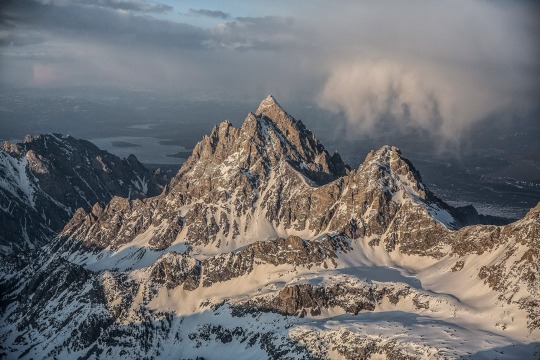
The towering granite crags of the Grand Teton range have drawn mountaineers, hikers, and photographers to this Wyoming park. Photograph By Jimmy Chin, National Geographic Image Collection
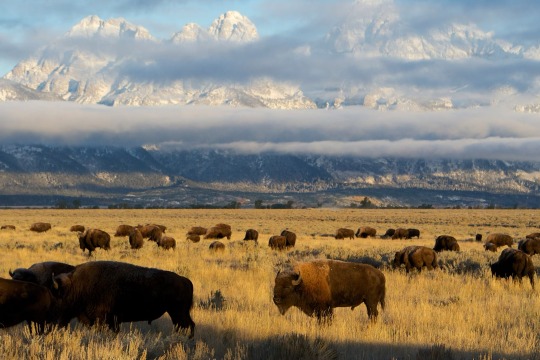
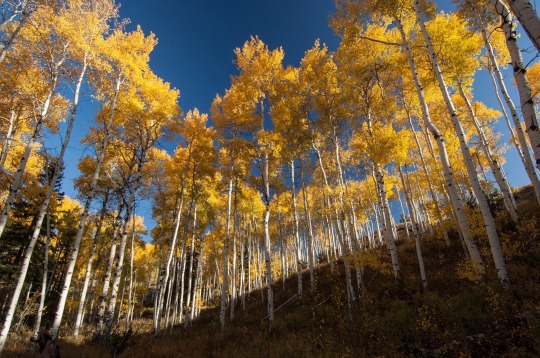
Left: Clouds drift above a herd of bison grazing in a valley in Grand Teton National Park. Visitors can also spot moose, bald eagles, ospreys, and pikas. Photograph By Barrett Hedges, National Geographic Image Collection. Right: In the fall, quaking aspen trees bring golden color to Grand Teton National Park. Photograph By Tom Murphy, National Geographic Image Collection
Some 200 years ago these majestic mountains were called Pilot Knobs by fur trappers because they could be seen from miles away. One of the Tetons’ tallest peaks, Teewinot, meaning “many pinnacles” in the Shoshone language, references the region’s ancestral roots. The 1800s homesteading tradition in the nearby town of Jackson gives the valley its moniker “The Last of the Old West.” Gazing out at verdant plains, towering crags, and fields of lemon-yellow balsamroot blooms, visitors understand why the park has become an emblem of the American West.
Why Go
Adventure athletes travel to the park to climb historic mountaineering routes, backpack into wildflower-strewn basins, or ski down advanced backcountry slopes in winter. But the park is also ideal for leisurely activities like biking, photography, and canoeing—set against the backdrop of the meandering Snake River, numerous lakes and streams, and the Grand Teton range.

Although a fraction of the size of nearby Yellowstone National Park, Grand Teton offers equally dramatic mountain vistas and impressive wildlife viewing. Outdoor photographer and Jackson local Steven Shelesky says it’s common to see wildlife, including elk, moose, pronghorn, and bison, while simply driving through the park.
Best Views
Shelesky says getting up early to catch a sunrise in the park is well worth the effort. “The entire Teton range is east facing, which makes for an amazing spectacle,” he says. Located about 350 yards from the parking lot, Schwabacher Landing offers particularly memorable views of a beaver pond off the Snake River. “You can see beautiful reflections of the Grand Teton on the water’s surface,” says Shelesky.

Sunset casts a rosy glow on the Snake River, in Grand Teton National Park, where families can go on scenic rafting tours. Photograph By Keith Ladzinski, National Geographic Image Collection
Nearby, the Snake River Overlook is another vista Shelesky recommends. The famous viewpoint captured by photographer Ansel Adams in 1942 highlights the curving river framed by the towering Tetons. Look for the Snake River Overlook turnout sign off Highway 191/89.
Best Hikes
Beginning at the Taggart Lake Trailhead on Teton Park Road, Taggart Lake is an easy hike that leads to a gorgeous lakeside picnic spot, where the Tetons reflect in the water. The three-mile round-trip trail rises just over 300 feet as it crosses bridges and weaves through a grove of quaking aspen trees, whose leaves tremble at the slightest breeze. For a more moderate hike, it’s well worth the extra steps to tack on the Taggart Lake-Bradley Lake Loop, which takes you 5.6 miles to both lakes. Both trails are also popular snowshoeing routes in winter.
Hikers looking for a more challenging route can follow the roaring Cascade Creek up the Forks of Cascade Canyon trail, where the glacially carved landscape leads to numerous viewpoints, including Inspiration Point and Hidden Falls. The 9.8-mile out-and-back route can be made more challenging during the day or as part of an overnight trip (permits required), by trekking 14.1 miles to Lake Solitude. You can book a round-trip ticket on the Jenny Lake Shuttle Service to avoid hiking an extra four miles roundtrip.
Best Drives
Teton Park Road and Highway 191/89/26 make a 42-mile loop that takes you to several pullouts and viewing sites in the park. Signal Hill Mountain Summit Road winds to the top of Signal Hill (nearly a thousand feet), where you’ll find two overlooks of the plunging Jackson Hole valley. The narrow road is five miles long and closed during winter.
Wildlife Spotting
Whether you’re on the slopes of Mt. Moran or canoeing Jackson Lake, wildlife abounds in Grand Teton National Park. Find elk and pronghorn in the sharp sagebrush of Timbered Island, just south of the Jenny Lake Visitor Center. Bison and moose roam the woods near various overlooks including Oxbow Bend along the Snake River, while bald eagles and osprey circle the sky.
Climb up the glacially carved Cascade Canyon trail and look for yellow-bellied marmots as you listen for the high-pitched chirp of pikas, a small lagomorph related to rabbits and hares. You just might see them collecting wildflowers and grass, which they store in hay piles for cold, snowy winters.
One of the park’s greatest attributes is its wildlife. To ensure your safety and theirs, obey the law requiring visitors to stay at least a hundred yards from bears and wolves and 25 yards from all other wildlife, including bison, moose, and pronghorn.
Posted speed limits are especially important in Grand Teton, which has seen increased wildlife collisions since 2000. Park officials advise extra caution during the fall, when animals migrate, and during low-light hours at dawn, dusk, and nighttime, when the speed limit is 45 miles per hour.
Visit Like a National Geographic Explorer
Wildlife biologist and National Geographic Explorer Autumn Iverson recommends getting an early start in Grand Teton. “Early in the morning is when birds and other wildlife are going to be more active,” says Iverson, whose work focuses on Brewer’s sparrows, a small songbird with a distinct call that lives in sagebrush. During her many field trips at dawn, she often saw elk, moose, and pronghorn, the second fastest land animal in the world.
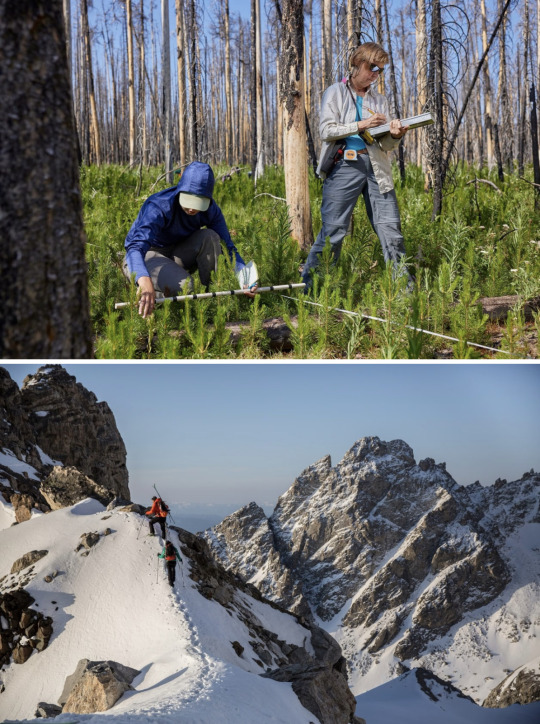
Top: Researchers count lodgepole pine seedlings near Flagg Ranch, where the 2016 Berry Fire—the largest in national park history—burned forests that were about 150 years old. Photograph By Sofia Jaramillo, National Geographic Image Collection. Bottom: Ski mountaineers trek up the crest on Mount Owen in Grand Teton National Park. Outfitters such as Exum Mountain Guides and Jackson Hole Mountain Guides lead visitors up into the Tetons in winter and summer. Photograph By Jimmy Chin, National Geographic Image Collection

Jackson Lake glimmers like a black-and-white photograph in the winter. The lake is a popular spot for ranger-led programs, wildlife spotting, and canoeing. Signal Mountain Lodge is located on these shores.

Jackson Lake glimmers like a black-and-white photograph in the winter. The lake is a popular spot for ranger-led programs, wildlife spotting, and canoeing. Signal Mountain Lodge is located on these shores. Photograph By Michael K. Nichols, National Geographic Image Collection
Iverson says she particularly enjoyed paddling one of the many lakes. That’s when “you get this whole expansive view of everything around you,” she says. Visitors can rent canoes or kayaks from Signal Mountain Marina and the Colter Bay Marina, among other outfitters. Paddling is generally recommended in the morning before afternoon winds arrive.
Activities and Excursions
The Tetons are a steep mountain range that have attracted mountaineers and climbers like Irene Ortenburger and Yvon Chouinard. Because of their steep pitch and high elevation, many of the park’s high-altitude trails may be inaccessible for the first-time hiker.
Experienced hikers are drawn to the park for its challenging backpacking routes, including the sought-after Teton Crest Trail, which follows the range’s spine through wildflower-filled peaks from Teton Pass to String Lake. Totaling 40 miles, the trail generally takes backpackers three to five days to complete. Apply for a permit six months in advance on Recreation.gov.
Ambitious hikers and mountaineers may opt for a multiday trip in the backcountry to make summit attempts on the coveted 13,775-foot Grand Teton. Exum Mountain Guides and Jackson Hole Mountain Guides lead visitors up the lofty peaks in summer and offer ski mountaineering trips throughout the winter.
Best For Families
From mid-June to September, the park puts on various complimentary interpretive programs, which generally occur at Jackson Lake Lodge, Colter Bay Village, and Headwaters Lodge and Cabins. Jackson Lake Lodge’s naturalist programs illuminate the world of wildlife in the park, including birds of prey, mountain lions, and grizzly bears. Ranger-led hikes, wildlife viewing, and campfire talks occur daily in the summer throughout the park at its many visitor centers. Check the event calendar for the latest listings.
Outfitters like Solitude Float Trips or National Park Float Trips guide families on scenic rafting tours on the Snake River. Rafts generally put in at Deadmans Bar and take two to three hours to float 10 miles to Moose Landing, passing through a mellow stretch of the river. Knowledgeable guides educate guests on the park’s history and point out fauna, including white pelicans, beavers, and bison. Fall can be particularly picturesque, when rafts float by quaking aspen trees studded with golden leaves and stately Colorado blue spruce.
Where To Stay
There are eight campgrounds and seven lodges within the park’s boundaries. Stay on the glimmering shores of Jackson Lake at the upscale Signal Mountain Lodge or find a more rustic option at American Alpine Club Grand Teton Climbers’ Ranch, which hosts communal cabins popular with climbers and other outdoor enthusiasts. The National Park Service lists more options on its website.
Campers have over a thousand sites to choose from, ranging from $10 to just over $100 per night. Book six months in advance through Recreation.gov. Colter Bay Tent Village has 66 “tent cabins” with wood walls and canvas tent roofs. The small cabins include covered porches, bunk beds, and wood-burning stoves.
Note that all lodges, cabins, and campsites within the park close during the winter, but there are plenty of options in the bustling town of Jackson. About 13 miles from the park’s Moose entrance, Jackson has numerous restaurants, historic hotels, and live music venues.
You can also find lodging in Teton Village at the base of Jackson Hole Mountain resort. The charming area is just under two miles from the park’s southern Granite Canyon entrance, making it a great basecamp for skiers.

The Milky Way glitters over the Grand Teton mountain range, in Wyoming. Photograph By Babak Tafreshi, National Geographic Image Collection
Need to know
The park is located in northwest Wyoming near the border of eastern Idaho, accessible via three entrances: Granite Canyon, Moose, and Moran Junction. Since Grand Teton is connected to Yellowstone National Park by the John D. Rockefeller, Jr. Memorial Parkway, most visitors tack Grand Teton onto a multiday trip to Yellowstone.
July and August are the most popular times to visit Grand Teton. May, September, and October see fewer crowds and cooler temperatures. Although wintertime shuts down many amenities and roads, it’s a great time to experience the region by snowshoe, cross-country skis, or snowmobile.
Spring can be an especially nice time to visit when portions of Teton Park Road open for a short time to cyclists, inline skaters, and other recreationists before cars are permitted in May. Before your trip, check the park’s alerts and current conditions page for road closures.
General Tips
Weather changes quickly in the Rocky Mountains, especially in the summer. Always pack extra layers and a rain jacket on all outdoor excursions. When venturing into the high country, start early so you can get below the treeline by noon, thereby avoiding afternoon thunderstorms, which can be violent.
Grand Teton National Park is black and grizzly bear country. The National Park Service recommends hikers carry bear spray, a non-lethal deterrent that’s EPA-approved.
Accessibility
While some visitor centers, campsites, and lodges are accessible, there aren’t many trails for wheelchair and other medical aid users, says Vasu Sojitra, the disability access advocate. He notes that the North Pathway, a 20-mile paved trail that connects Jackson, Wyoming, with the park at Jenny Lake, is one of the more accessible areas in the region. “It is a really great way to experience and make a bigger day out of visiting the park,” he says.
#United States 🇺🇸#National Parks 🏞️#Grand Teton National Park 🏞️#National Geographic#Rocky Mountains ⛰️#Ultimate Trip#American 🇺🇸 West
4 notes
·
View notes
Note
Inosuke is slimetown's equivalent of Bigfoot and Zenitsu is an electrician but he's so bad at it
INOSUKE IS YET ANOTHER CRYPTID SPOTTED AT GRIMETOWN NATIONAL PARK BUT HE JUST LIVES THERE
#stepdaddy merc#transchainsawman#repeat offenders#zenitsu is an electrician and he passes out from anxiety and then miraculously fixes everything with ease#📍🏞️ GRIMETOWN NATIONAL PARK
10 notes
·
View notes
Text

The last time I made it to Nevada Falls 🏞️
#bay area#bayarea#norcal#northern california#photography#my photos#yosemite#national park#🏞️#nevada falls#hiking#🥾#adventure
1 note
·
View note
Text

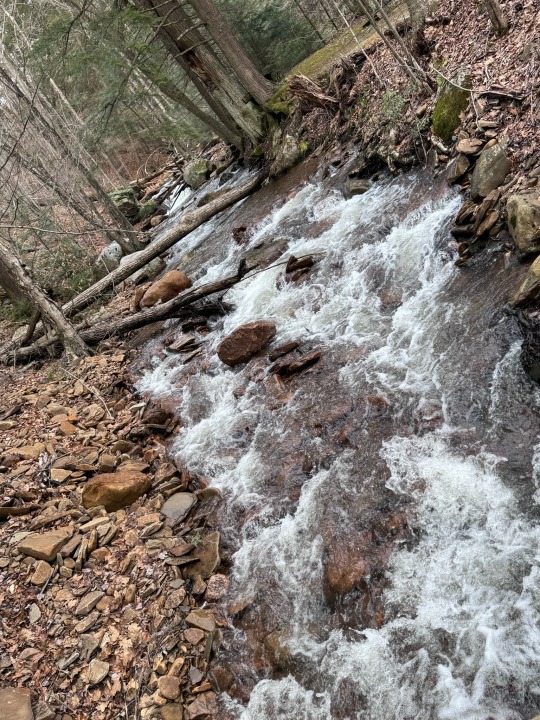



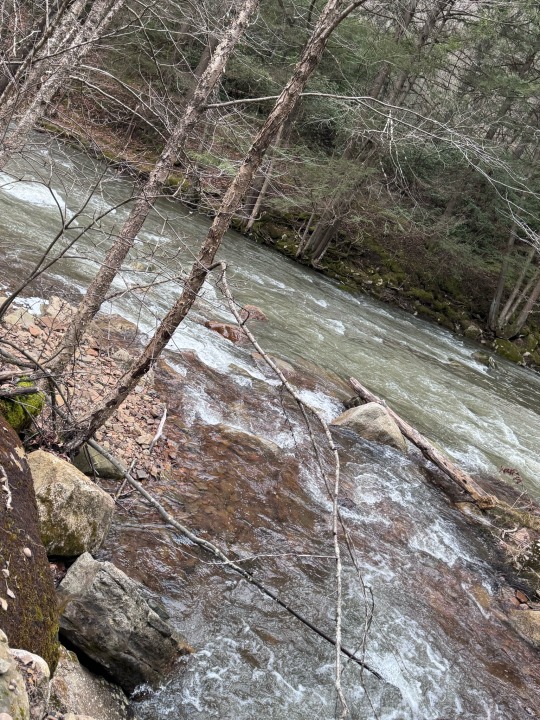
Went on another date with this cutie pie! Today we took a trip out to a national park 🏞️. It was absolutely gorgeous! I’ve lived here for a while now and it still amazes me how beautiful it is everyday. I’ve said it before and I’ll say it again I live in one of the beautiful places on earth!
#national park#beautiful#nature#trans#transgender#trans pride#transisbeautiful#mtf#transgirl#girlslikeus#mtf hrt#maletofemale#transformation#btw she definitely likes me#i’m so 🥰🥰🥰#trans women#trans woman#trans women are beautiful#trans women are women#transexual#actually trans#this is what trans looks like#trans community#trans experience#trans fem#trans feminine#trans girl#trans goddess#trans is beautiful#trans positivity
577 notes
·
View notes
Text





🏞️🏜️🌄🌅National park scene watches from asteriskwatches on tiktok!🌅🌄🏜️🏞️
#stimboard#moodboard#stim#visual stim#hands#watch#watches#timepiece#wristwatch#national park#nature#waterfall#volcano#aurora borealis#seal#kelp forest#kelp#blue#white#red#orange#green#grey#gray#yellow#brown#black#polar bears#desert
37 notes
·
View notes
Text

[ID: Text in the center says Polyam Shipping Day, 14th of every month, Jan 2025 - Reflect. Below Polyam Shipping, and to the left of Day, is a red infinity sign that finishes in a heart on top. Surrounding the text are rows of stylized hearts in the colors of both versions of the polyam pride flag (black, red, bright blue, light green, dark green, light blue, navy). Either side of the prompt are emojis, mirror on the left and national park on the right. /end ID]
January 14th 2025 is our 45th Polyam Shipping Day.
The optional theme for it is: 🪞Reflect🏞️
This could be about moments of introspection, where a character seeks time alone to reflect on their life and choices. What about characters who reflect in the presence of others, where unspoken words allow for deeper connection or insight? It could be about the reflective stillness before a major decision, where the weight of possibilities grows heavier. Or, what about characters reflecting on what they’ve lost, finding peace in the quiet acknowledgement of their grief? For a twist, consider reflection literally: a reflection on a mirror, water or a window. What about reflecting a battle move or a spell? Or characters whose movements in battle reflect how much they know each other?
…
We’ll be tracking #PolyamShippingDay, and keeping an eye out for any @polyamships mentions too. We will reblog any polyam-positive fanworks featuring polyamorous ships of any configuration/type from any fandom. All ratings are welcome but anything nsfw/triggery should be warned for and behind a read more, as should very long tumblr fic.
You can also submit works directly to the blog or send us asks to let us know to check your blog for a post. If you’re posting on AO3, our collection name is ‘PolyamShippingDay‘ and you can post to the collection here. Only fanworks submitted/@ us on tumblr or in the official AO3 collection, or fanworks posted to our Dreamwidth community, are guaranteed to be included in our roundup. Please also let us know what prompt you created for, if any - people are always welcome to create for past prompts instead.
We have a Discord - invite here - if you want a place to chat about your ships or what you’re creating for them.
We look forward to seeing what people create for it. If you’re enthused about the day, we’d be especially appreciative of any reblogs to help spread the word about the event.
#OT3#OT4#PolyamShippingDay#polyshipping#polyshippingday#polyships#poly shipping#poly ships#polyamships#polyam ships#polyam shipping#polyamorous shipping#polyamorous ships#polyamory#modposts#polyamships prompts#PolyamShippingDay prompts#prompt: reflect
23 notes
·
View notes
Text
Pick A Card And Discover the Dream Destinations Your Future Spouse Will Adore! ✈️🌍💖

Instructions: Look at the 3 images of the piles below. Choose the pile that you feel most drawn to. Trust your intuition and select the one that resonates with you the most. Once you have made your choice, scroll down to read the description for the pile you selected. 🌈🔮
I put a lot of effort into this reading, so please show some love by leaving comments, likes, reblogs, and follow me! ❤️💬✨
Paid psychic reading (7 questions for just $7) is available here:
Pile 1:
Six of Swords ⛴️🌅
Nine of Cups 🥳✨
Two of Wands 🌍🗺️
The Six of Swords represents travel over water and moving towards calmer shores, suggesting your future spouse will enjoy tranquil beach destinations or serene retreats. The Nine of Cups signifies wishes fulfilled, indicating they will appreciate places that bring them joy and satisfaction, like luxury resorts or favorite vacation spots. The Two of Wands symbolizes planning and exploration, suggesting a desire to venture into new territories. Together, these cards suggest that your future spouse will love destinations that offer relaxation, luxury, and opportunities for exploration! 🌴🏖️💖 Love this post? Spread the positive vibes by reblogging with your favorite pile number! Remember to like, comment, and follow me for more tarot insights and spiritual guidance. By sharing this post, you'll invite positive energy from the universe into your life. Let's journey together towards enlightenment and fulfillment! 🌠✨💕
Pile 2:
The Chariot 🚗💨
Eight of Wands ⚡🚀
The World 🌎🌟
The Chariot symbolizes determination and movement, suggesting your future spouse will love destinations that involve adventure and road trips, like exploring national parks or vibrant cities. The Eight of Wands signifies swift action and travel, indicating they will enjoy spontaneous trips or quick getaways that offer excitement. The World card represents completion and travel to foreign lands, suggesting they will love immersing themselves in different cultures and experiences around the globe. Together, these cards imply that your future spouse will adore destinations that are dynamic, adventurous, and culturally enriching! 🌍✨🏞️ Love this post? Spread the positive vibes by reblogging with your favorite pile number! Remember to like, comment, and follow me for more tarot insights and spiritual guidance. By sharing this post, you'll invite positive energy from the universe into your life. Let's journey together towards enlightenment and fulfillment! 🌈💖🌟
Pile 3:
Four of Wands 🎉🏡
Queen of Pentacles 👑💵
Seven of Cups 🌈💭
The Four of Wands signifies celebration and home, suggesting your future spouse will love cozy, comfortable destinations like charming cabins or family gatherings in scenic spots. The Queen of Pentacles represents practicality and comfort, indicating they will enjoy places that feel nurturing and luxurious, like spa retreats or vineyard tours. The Seven of Cups symbolizes dreams and choices, suggesting they will appreciate a variety of travel experiences, from relaxing getaways to exotic adventures. Together, these cards imply that your future spouse will cherish destinations that offer comfort, celebration, and a touch of fantasy! 🌸🏞️💖 Love this post? Spread the positive vibes by reblogging with your favorite pile number! Remember to like, comment, and follow me for more tarot insights and spiritual guidance. By sharing this post, you'll invite positive energy from the universe into your life. Let's journey together towards enlightenment and fulfillment! 🌟🌈💕
Attention! This reading is for entertainment purposes only. This tarot reading does not give a 100% guarantee that all the described situations will occur or being ultimate truth. You build your own life and destiny and only you know yourself best. Remember to reblog, like, comment, and follow for more cosmic guidance and positivity! 🌌💖
Paid readings (7 questions for just $7) are also available for more in-depth insights and personal guidance! 🌟💫
#divination#psychic#tarot reading#free readings#pick a card#pick a pile#free tarot#daily tarot#tarot community#tarotblr#tarot cards#tarot#future spouse#astrology#spirituality#crystals#witchcraft#meditation#manifestation#witchblr#spiritualawakening#mysticism#numerology#occult#wicca#tarot deck#pac reading
25 notes
·
View notes
Text

Definetly, the film is a “flaunt" Sam Heughan flaunting his body. He's been saying the same thing in all his interviews over and over again, he just changes the interviewer and magazine.

Supposedly the MGM film aimed to promote the second part of Season 7 of "Outlander" not to showcase Sam Heughan’s struggle to ride a white horse or display the wardrobe selected by his stylist. But…Don’t objectify me! 🤔 one thing is true Nobody is forcing you to do that.






His interview coincided conveniently with the discovery of Andrew Irvine's century-old foot on the northern face of Mount Everest, allowing him to announce his upcoming visit to Nepal.
If he pretends to hike the iconic Everest Base Camp Trek through the Khumbu Valley, allowing him to surround the Sagarmatha National Park 🏞️ he’ll simultaneously the breath-taking vistas of 4 of the 6 highest peaks in the world – Mt. Everest (8.848m), Mt. Lhotse (8,516 meters), Mt. Makalu (8,470 meters) and Cho Oyu (8,201 meters). BTW, He’ll visit the Everest region doesn't necessarily mean climbing Mount Everest. 🗻
Posted 19th November 2024

18 notes
·
View notes
Text

Mountain view window giving your home a serene touch, as if in the middle of a national park 🏞️ Enjoy! 🌷
#animalcrossing#nintendo#ac community#あつまれ どうぶつの森#acnl#milaslovelywindows#animal crossing#animal crossing community#acnl community#animal crossing new leaf#achhd#animal crossing designs#animal crossing patterns#animalcrossinqrcodes#animalcrossinghappyhomedesigner#acnl blogging#nintendo 3ds#doubutsu no mori#2000s nostalgia#nostalgic game#retro gaming
15 notes
·
View notes
Text

📍Torres del Paine National Park, Chile 🇨🇱🏞️
📷 Brayden Hall
#Torres del Paine National Park#Chile#Torres del Paine#National Park#Brayden Hall#Nature#Travel#Photography
14 notes
·
View notes
Text
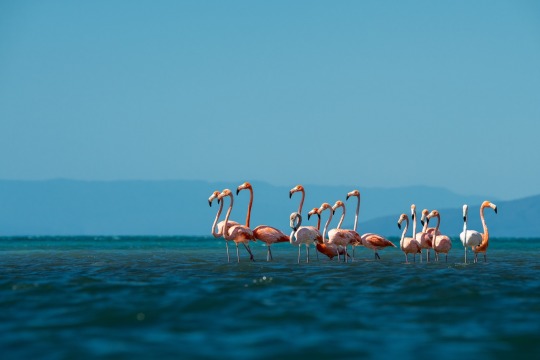
A wild flamingo population gathers on Los Corbanitos beach in Sabana Buey, a town in the Dominican Republic. The birds are not threatened, though anecdotal evidence suggest their numbers are declining in the country. Photographs ByFernando Faciole
‘Selfie’ Flamingos In Caribbean Resorts Are Being Returned To The Wild
Up to a hundred Caribbean flamingos live in resorts, where they form a backdrop of tourists’ social media posts. Now, bird lovers are stepping in to remove them.
— ByJessica Taylor Price | March 06, 2024
At several resorts in Punta Cana, Dominican Republic, flamingos wander the grounds, wading through artificial ponds and foraging any bits of food dropped by tourists.
Visitors post photos and videos of themselves getting close to the birds on social media, attracted to the exoticism of the pink, leggy animals against the backdrop of a tropical beach vacation.
But behind the charming social media posts, things are less rosy for the flamingos.
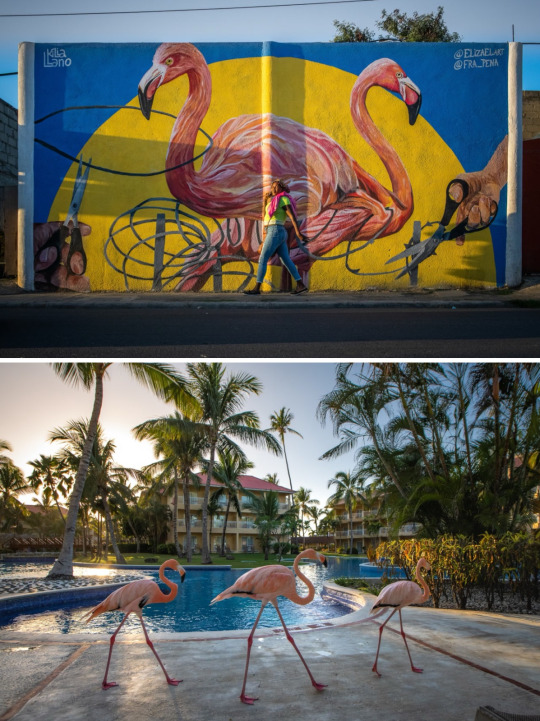
Top: In the town of Monte Cristi, a mural by artist Kilia Llano highlights the issue of flamingos being captured from the wild. Bottom: Three flamingos walk through a resort in the Bávaro region. Tourists often feed the birds and take photos with them, especially around the pool.
Though the International Union for Conservation of Nature lists the Caribbean—also known as the American—flamingo as “of least concern,” anecdotal evidence suggests the population is declining on the Caribbean island, says Maria Milagros Paulino, director of the Dominican nonprofit Grupo Accion Ecologica.
“When you see flamingos, you see them in groups, so it gives the appearance that they are numerous,” Paulino says through a translator.
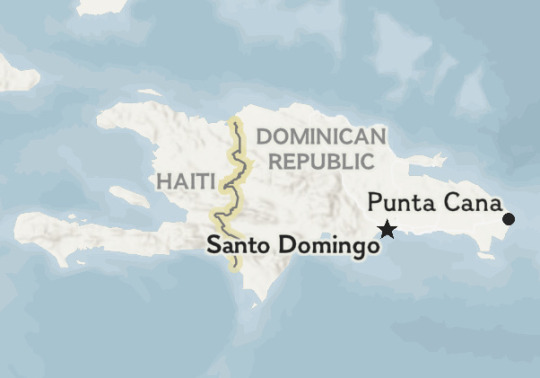
Map
The phenomenon of flamingos living at resorts had been trending upward for years, especially in the Bávaro region of Punta Cana, says Eladio Fernandez, a Dominican conservationist and photographer. In 2020, he conducted an informal census of how many birds lived in Bávaro resorts by scrolling through TripAdvisor photos. It’s not known exactly how the flamingos arrived at the various resorts and who is involved in bringing the birds there.
According to Fernandez, personnel from the hotels themselves don’t know where the flamingos came from, in some cases they’ve been there a long time and personnel rotate in and out.
In 2020, he counted 163 flamingos in 41 hotels. Anywhere between a thousand and 3,000 Caribbean Flamingos live in the Dominican Republic. Since those birds don’t breed, they’re not replenishing the population, Fernandez says.
So, in collaboration with the Ministry of Environment and Natural Resources, the National Zoo in Santo Domingo, and Grupo Accion Ecologica, he spent three years coordinating and fundraising to launch a nonprofit called Rescate Rosado, which translates to “pink rescue” in Spanish.
Ministry employees pick up the flamingos, then transfer them to Rescate Rosado and zoo employees, who eventually release them back into the wild, Fernandez says. So far, the nonprofit has removed 66 birds from resorts in the Dominican Republic—and they say they’re just getting started.
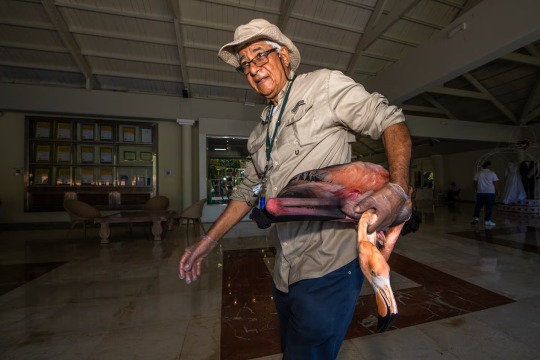
Nelson García Marcano, the Dominican Republic's director of the Department of Biodiversity and Wildlife of the Ministry of Environment, removes a flamingo from a Bávaro resort. This animal is part of the Rescate Rosado's first-ever rescue.
Because of the efforts to remove the flamingos, there should be fewer than a hundred living at Bávaro resorts—but it’s difficult to know for sure, Fernandez says.
Death Traps
On the other side of the country, at Monte Cristi National Park, the pristine resort environment is nowhere to be found. Instead, there are salty lagoons and muddy mangrove swamps accessible only by motorcycle.
This is the natural habitat for Caribbean flamingos; it's also a popular trapping site. And it is here that Paulino, a collaborator with Rescate Rosado, works to remove the traps, which are made of wooden stakes attached to two lassos of fishing wire.
Paulino's group first noticed the traps in 2009 and has been reporting them to the authorities ever since, but the practice hasn’t stopped, and is expected to pick up again this winter and spring, Fernandez says. Once, Paulino says, she spotted a trapper carrying nine flamingos in a bag. On a trip early in 2023, Grupo Ecologico took 706 traps from three locations.
The crude method of trapping can also harm, or even kill, the birds, which Fernandez has seen firsthand in the field. A flamingo could be walking around and "all of a sudden their leg falls in the lasso and when they pull, they're caught," says Fernandez. They could be trapped by a knee or an ankle, and struggle to break free, which exhausts them, especially as the water bogs down their wings.

Top: A rescued flamingo, one of many whose feathers have been clipped to prevent escape from hotels and resorts, enters rehabilitation at the National Zoological Park of the Dominican Republic. Bottom: Trappers use a crude system of wooden stakes attached to fishing wire to ensnare the birds.
The trappers, meanwhile, might not come back for days, leaving the birds—or any other animals caught in the device—in a precarious position. "It's a death trap for the flamingo if they don't get pulled out soon," Fernandez says.
The first time Fernandez went to Monte Cristi National Park to look for traps with Paulino, they found a dead flamingo still in a trap. It had likely been there for months.
Birds In Trouble
"Some [resort flamingos] are well taken care of, and others aren't," Fernandez says.
Some of these flamingos have their secondary feathers cut, which thwarts flight, as Fernandez has observed. Others have a bone surgically removed from their wings, he says. This grounds the bird for life, which can be up to 60 years, says Fernandez. It is not known who cuts the feathers or removes the bones.
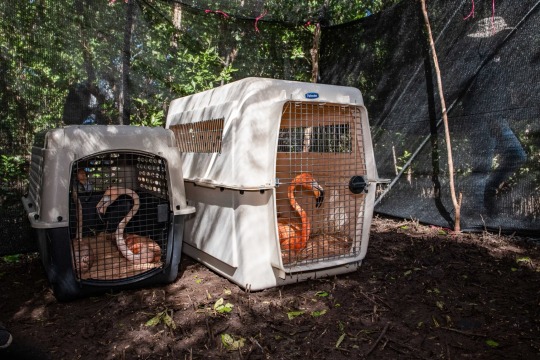
Flamingos await release at Monte Cristi National Park.
Several resorts housing flamingos declined to be interviewed for this article.
Fernandez has also witnessed flamingos being given pet food, which eventually fades the vibrant pink color that comes from eating their native diet of shrimp and other small crustaceans. The birds change behaviorally as well, becoming used to people and soliciting them for food, as Fernandez has seen.
But there's at least one trait the flamingos perhaps haven’t lost. Fernandez has seen one instance in which flamingos, which form tight social bonds, stayed by the side of a captive wing-clipped companion.
Two former flamingo hunters are working with the project, sharing their knowledge of trapping. And people are calling out influencers on social media who post photos of the resort flamingos.
On a bigger scale, Fernandez will participate in a formal flamingo census in 2024, which he hopes may lead to the species being listed as endangered in the Dominican Republic.
"This is something we can fix. We can right a wrong," Fernandez said.

An aerial view shows the lagoon where the flamingos will be released in Monte Cristi National Park.

A member of the National Zoo carefully holds a Flamingo. All animals need to be massaged so that blood circulates properly to their feet.
An Emotional Release
In February 2023, guests watched as eight flamingos were removed from a Bávaro resort that cooperated with the rescue. The birds, wrapped in pantyhose to keep them immobilized, were transported in a pickup truck to the national zoo, where they were examined.
The conditions of the birds varied, says Tatiana Carreño Pinto, a zoo veterinarian. Some were underweight, whereas some are too heavy to fly, but all were generally healthy.
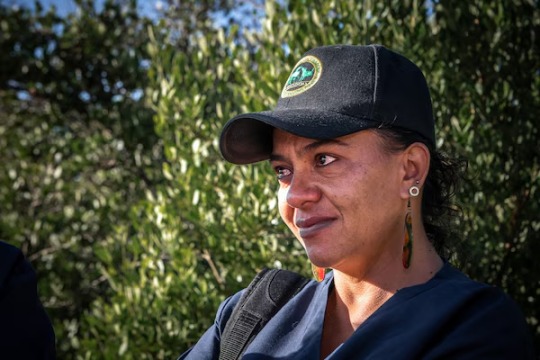
Tatiana Carreño, a Veterinarian at the National Zoo of the Dominican Republic, is moved and cries when she sees the newly released flamingos flying.
Once vets examine the birds, they’re put in an isolated corral for two to three months, and, in this controlled setting, deliberately frightened to regain their natural fear of people.
One morning later that month, scientists loaded 12 flamingos into a truck and drove them to Monte Cristi National Park. Once there, veterinarians massaged their legs to promote circulation.
Then, a boat transported the birds to the lagoon, where another corral awaited them under black mangrove trees. They opened their wings and walked in the confined space, where the flamingos would adjust to their new environment.
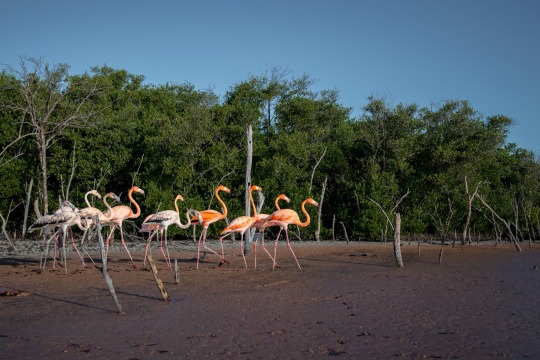
The newly released animals explore their new home.
The next morning, it was go time. The 12 flamingos, seven of which were from resorts, flew or walked away into the lagoon as the rescue team watched, Fernandez says.
"It was very emotional," Pinto says in Spanish. "It was inevitable to cry.”
#Animal Rescue#Greater Flamingo 🦩🦩🦩#Animal Rehabilitation#Tourism#Luxury Travel 🧭 🧳#Animal 🦔 🦓 🦒 Welfare#Caribbean Resorts#Punta Cana | Dominican Republic 🇩🇴#Bávaro Resort#Tatiana Carreño Pinto | Zoo Veterinarian#Monte Cristi National Park 🏞️#Nelson García Marcano#Punta Cana#Eladio Fernandez | Dominican Republic 🇩🇴 | Conservationist | Photographer#Caribbean Flamingos 🦩🦩🦩#Ministry of Environment & Natural Resources | The National Zoo | Santo Domingo | Grupo Accion Ecologica#Rescate Rosado
0 notes
Note
Mentions of Toji’s rat army NEVER fail to make me laugh. I need lore: has Toji always been a rat whisperer? Is it hereditary can naoya speak rat? Can megumi command rats? Or is it like a ratatouille where one rat can talk to Toji and that one rat commands the other rats?? Or do they just symbiotically coexist and Toji reaps the benefits of a rat army
ALEKS, NOT ONLY CAN NAOYA SPEAK RAT – HE IS A RAT!
BUT ANYWAYS... yes, toji has always been a rat whisperer, like how in the manga he was born with heavenly restriction. in the slimeball world, he was born with the innate ability to command rats and freeload like nobody else. megumi can command rats but he has yet to figure this out, but he's getting a little confused as to why all types of rodent swarm him during his daily patrol at grimetown national park.
#stepdaddy merc#princess-okkotsu#naoya is kinda sexy in a rat way#also he went from dealer > jobless > ripping off local grimetown businesses#so he is a professional rat bastard#repeat offenders#📍🏞️ GRIMETOWN NATIONAL PARK
8 notes
·
View notes
Note
Have the best trip lovely, what you have planned sounds so good!! 🏞️☀️
If I remember correctly you’ve shared some of your own photography on here right? I’d love to see what you capture this time ❤️

Thank you! It’s been a long day. We drove from Las Vegas to Zion National Park and it’s gorgeous here. I haven’t had time to sort through my photos yet but here are some from my phone. We’ll explore Zion again tomorrow and then head to Bryce Canyon after.
I’m traveling with my parents so no intense hikes but the views are still gorgeous. ☺️ Photos organized by shuttle stop.
Court of the Patriarchs

Temple of Sinawava


The Grotto


We stopped in Las Vegas briefly but will go back on Friday. We drove around, sat in traffic, and decided it was time for bed at 9pm. 😂



19 notes
·
View notes
Photo

Captured the breathtaking vistas of Big Bend National Park, where towering cliffs meet an expansive sky dotted with clouds. Take a moment to soak in the serene beauty of this natural wonder. 🏞️✨
#Big Bend National Park#nature photography#breathtaking views#towering cliffs#expansive skies#cloudscape#serene landscapes#travel#outdoor adventure#national parks#Texas#landscape photography#natural wonders#hiking#tranquility
7 notes
·
View notes
Text
The Fascinating World of Extinct Animals: Stories of Lost Species and Conservation Lessons 🌍✨

The DODOD Introduction The story of extinct animals is both a testament to the fragility of life and a reflection of the ever-changing nature of our planet. 🌎💔 Extinct animals, those species that no longer exist, capture our imagination and serve as poignant reminders of the impact humans and natural events have on biodiversity. 🐾📜 In this article, we delve into the causes of extinction, profile some notable extinct animals, and highlight the importance of conservation efforts to prevent further losses. 🛡️🌿 Notable Extinct Animals 1. The Dodo (Raphus cucullatus) Habitat: Mauritius, Indian Ocean 🏝️ Extinction Date: Late 17th century 📜 Causes: The dodo was driven to extinction by a combination of hunting by sailors and predation by introduced species such as rats, pigs, and monkeys. Habitat destruction also played a role. 🚢🐀🐖 2. The Passenger Pigeon (Ectopistes migratorius) Habitat: North America 🌎 Extinction Date: Early 20th century (1914) 📜 Causes: Once numbering in the billions, passenger pigeons were hunted extensively for food and sport. Deforestation also destroyed their natural habitat. 🏞️🍂 3. The Tasmanian Tiger (Thylacine) Habitat: Tasmania, Australia, New Guinea 🌏 Extinction Date: 20th century (1936) 📜 Causes: Hunting, habitat destruction, and competition with dogs contributed to the decline of the Tasmanian tiger. Government bounties also encouraged widespread killing. 🐕🏞️ 4. The Great Auk (Pinguinus impennis) Habitat: North Atlantic coasts 🌊 Extinction Date: Mid-19th century (1844) 📜 Causes: The great auk was hunted for its feathers, meat, and oil. Overharvesting of eggs and human disturbance of breeding sites also led to its extinction. 🌊🐦
5. The Woolly Mammoth (Mammuthus primigenius) Habitat: Northern Hemisphere (Europe, Asia, North America) 🌍❄️ Extinction Date: Approximately 4,000 years ago 📜 Causes: Climate change at the end of the last ice age reduced their habitat. Additionally, overhunting by early humans played a significant role in their extinction. 🌡️🏹 Causes of Extinction 1. Natural Causes Climate Change: Historical climate shifts, such as the ice ages, have drastically altered habitats, leading to the extinction of many species unable to adapt. ❄️🌡️ Natural Disasters: Volcanic eruptions, asteroid impacts, and tsunamis can create immediate and long-term changes to environments, wiping out species. 🌋☄️🌊 Predation and Competition: Evolutionary pressures, including predation and competition for resources, have naturally led to the extinction of less adaptable species. 🐅🍃 2. Human-Induced Causes Habitat Destruction: Deforestation, urbanization, and agriculture reduce the natural habitats of many species, leading to their decline. 🏞️🪓🏘️ Overexploitation: Hunting, fishing, and poaching have driven many species to extinction by depleting their populations faster than they can reproduce. 🎣🏹💔 Pollution: Industrial waste, pesticides, and plastics contaminate ecosystems, causing health problems and deaths in wildlife. 🏭🧴🐢 Climate Change: Human activities such as burning fossil fuels contribute to global warming, affecting the natural habitats and lifecycles of many species. 🌍🔥🏭 Introduction of Invasive Species: Non-native species introduced by humans can outcompete, prey on, or bring diseases to native species, leading to extinction. 🐍🌱🌏 The Importance of Conservation The extinction of species has a profound impact on ecosystems and the services they provide. 🐾🌿 Biodiversity is crucial for maintaining ecological balance, pollination of plants, purification of water, and many other functions essential for life on Earth. 🌍💧 Conservation efforts are vital to protect the remaining species and prevent further extinctions. Here are some key strategies: Protected Areas: Establishing national parks and wildlife reserves to safeguard habitats. 🏞️🛡️ Legislation: Enforcing laws against poaching, illegal logging, and trade in endangered species. 📜🚫 Captive Breeding Programs: Breeding endangered species in captivity to reintroduce them into the wild. 🦏🐣 Habitat Restoration: Rehabilitating degraded ecosystems to support wildlife. 🌱🏞️ Climate Action: Mitigating climate change by reducing greenhouse gas emissions. 🌍🔥 Public Awareness: Educating people about the importance of biodiversity and conservation efforts. 🧑🏫🌿
Conclusion The history of extinct animals is a sobering reminder of the delicate balance of life on Earth. 🌍💔 While the loss of species like the dodo and the Tasmanian tiger can never be undone, we can learn from these events to better protect the remaining biodiversity. 🐾🌿 Through concerted conservation efforts, we can strive to preserve the natural world for future generations, ensuring that more species do not meet the same fate as those that have already been lost. 🌍💚 Join the Conversation! 🌟 If you found this article informative, please like, comment, and share it with fellow wildlife enthusiasts. Together, we can make a difference in protecting our planet's incredible wildlife. 🌟

The Mammoth
#animal#planet#wildlife#plants#animals#nature#forest#nature photography#naturelovers#photos#extinct animals#biodiversity#conservation#wildlifeprotection#saveourplanet#ecofriendly#nature lovers#greenliving#preservenature
14 notes
·
View notes
Text


National Park Trust Buddy Bison 🏞️
4 notes
·
View notes